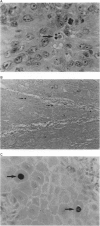Abstract
Forty-two oral squamous cell carcinomas (SCCs) were analysed for p53 mutations and human papillomavirus (HPV) infection to examine the prevalency of these factors and correlation with apoptotic index (AI; number of apoptotic cells per 100 tumour cells) of the tumour tissue. In polymerase chain reaction (PCR)-Southern blot analysis, HPV DNAs were detected from 22 out of 42 SCCs (52%) with predominance of HPV-16 (68%). p53 mutations in exons 5-8, screened by nested PCR-single-strand conformation polymorphism (PCR-SSCP) analysis, were observed in 16 of 42 tumours (38%). The state of the p53 gene did not show any correlation with HPV infection. The terminal deoxynucleotidyl transferase (TdT)-mediated dUTP-biotin nick end labelling (TUNEL) method was used for detection of apoptotic cells. The mean AI was 2.35, ranging from 0.31 to 6.63. SCCs associated with p53 mutation had significantly lower AI than those without p53 mutation (P < 0.01), whereas no difference in AI was found between SCCs with and without HPV infection. The results of this study confirmed that HPV infection and/or p53 mutations are implicated, but are not mutually exclusive events, in carcinogenesis of oral SCC and also showed that decrease in apoptosis is more closely related to p53 mutation than HPV infection.
Full text
PDF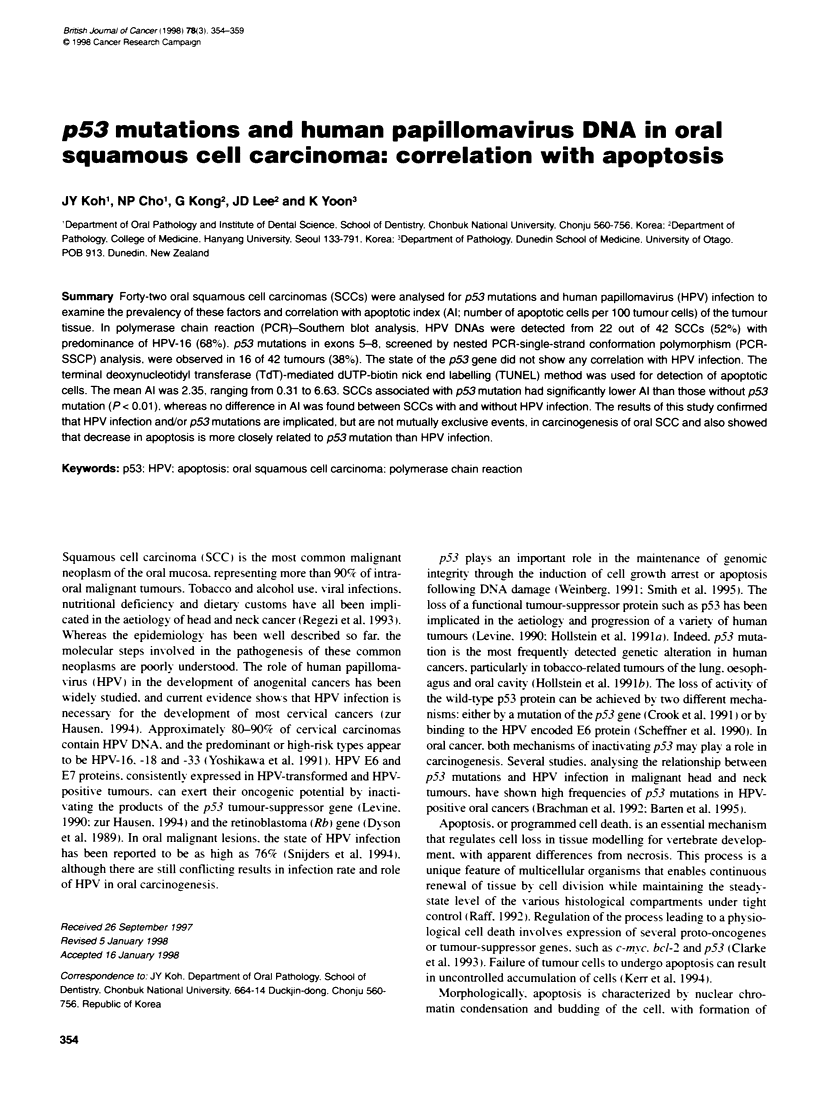
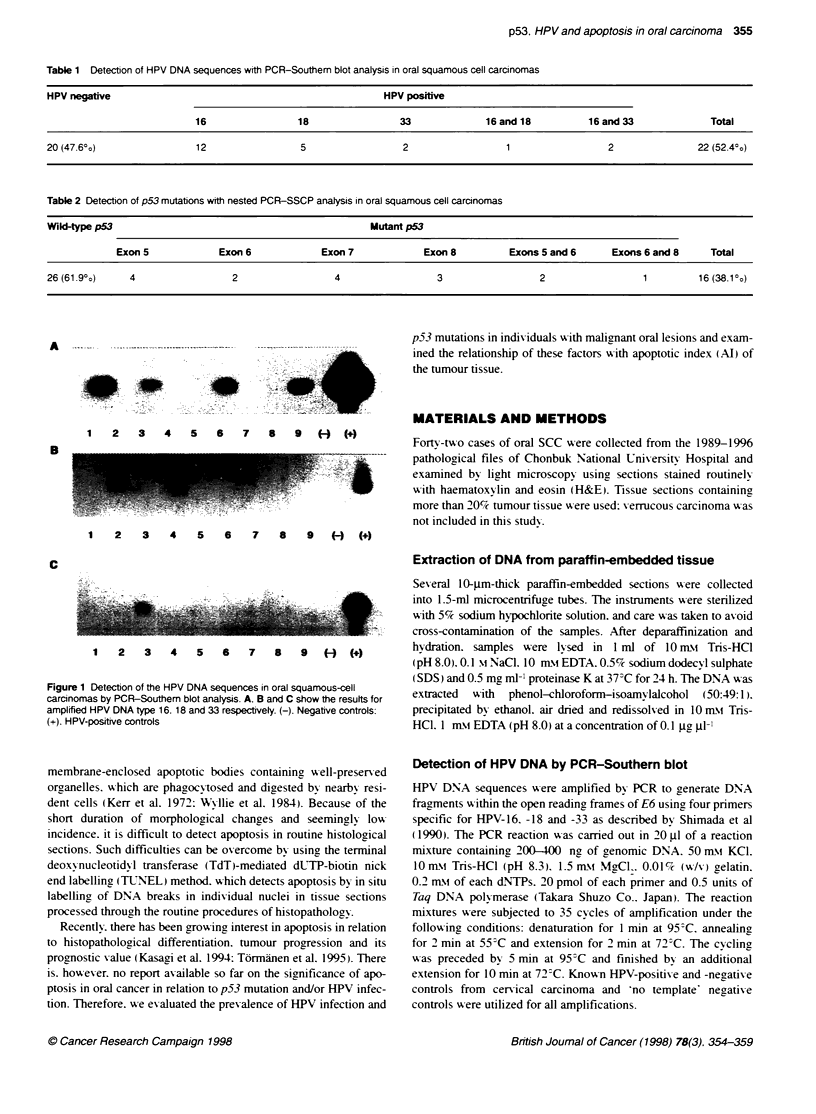
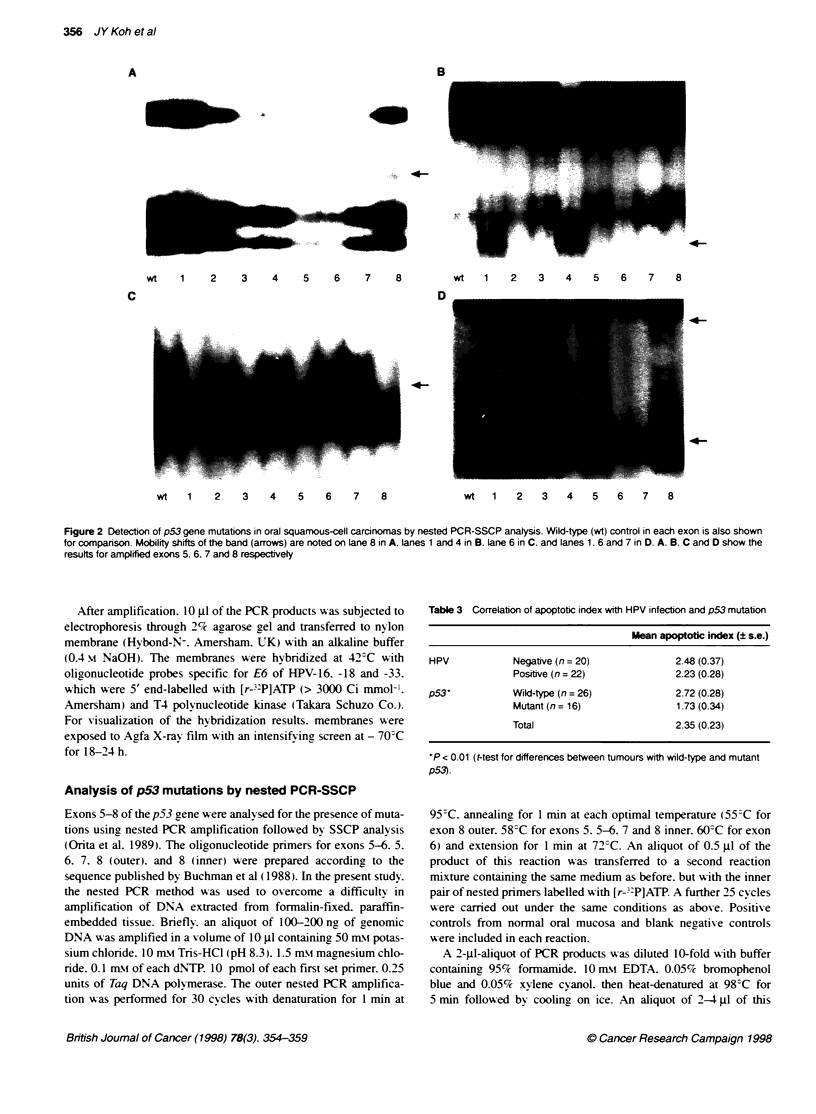
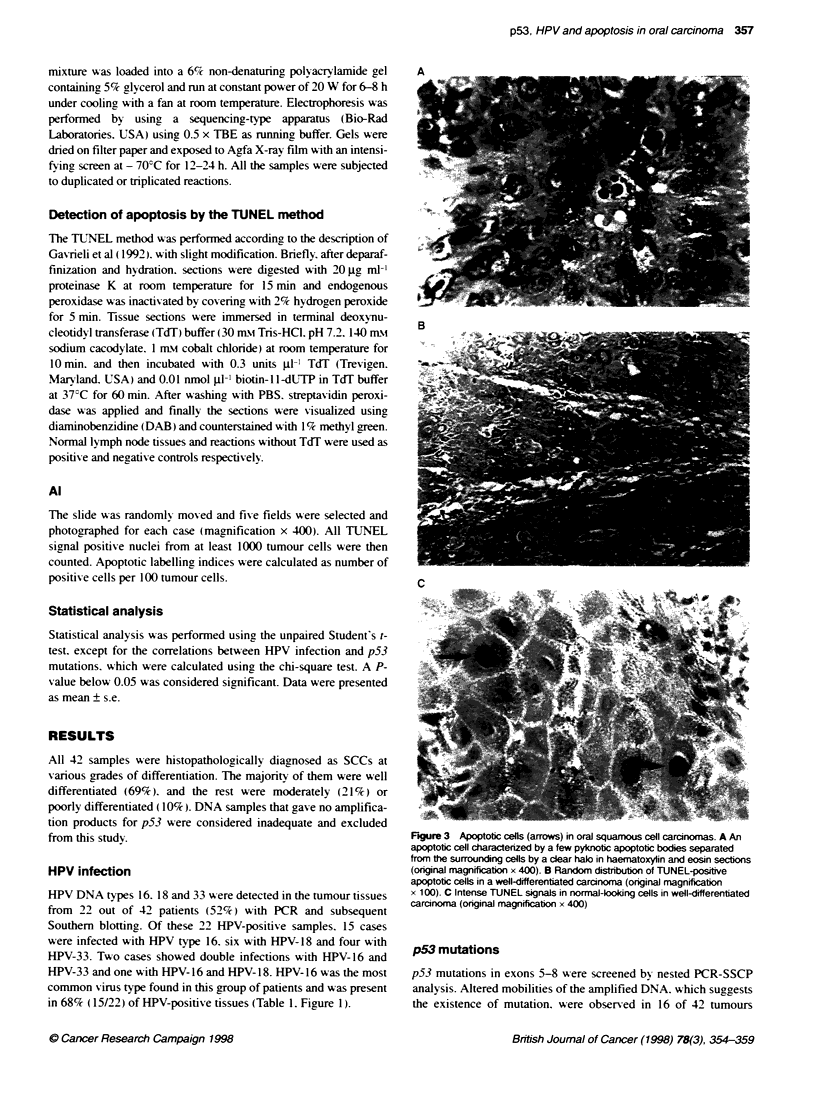
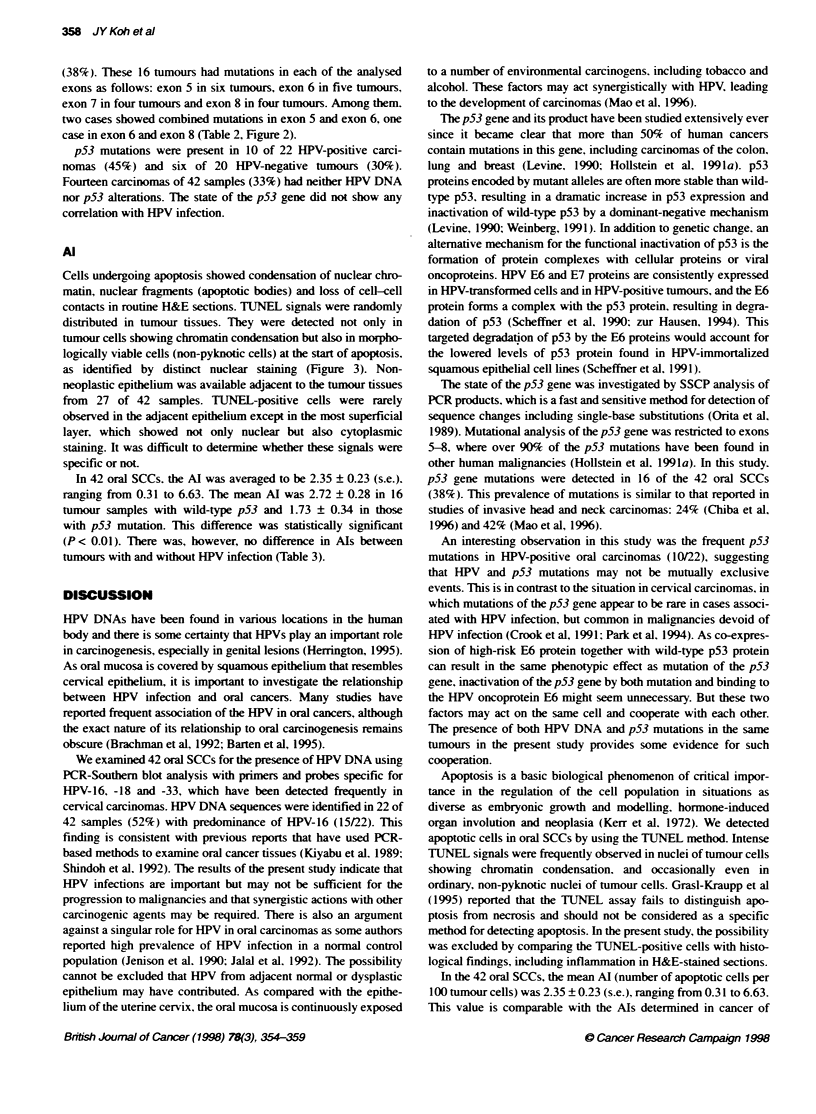
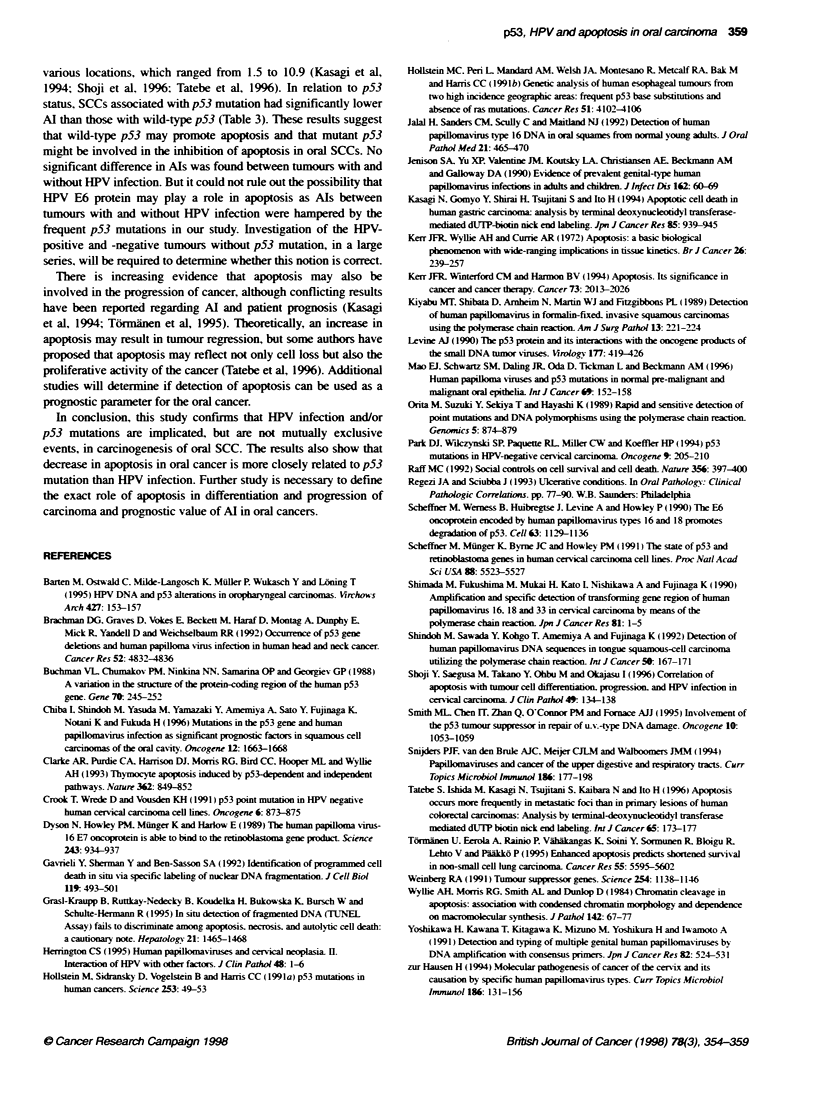
Images in this article
Selected References
These references are in PubMed. This may not be the complete list of references from this article.
- Barten M., Ostwald C., Milde-Langosch K., Müller P., Wukasch Y., Löning T. HPV DNA and p53 alterations in oropharyngeal carcinomas. Virchows Arch. 1995;427(2):153–157. doi: 10.1007/BF00196520. [DOI] [PubMed] [Google Scholar]
- Brachman D. G., Graves D., Vokes E., Beckett M., Haraf D., Montag A., Dunphy E., Mick R., Yandell D., Weichselbaum R. R. Occurrence of p53 gene deletions and human papilloma virus infection in human head and neck cancer. Cancer Res. 1992 Sep 1;52(17):4832–4836. [PubMed] [Google Scholar]
- Buchman V. L., Chumakov P. M., Ninkina N. N., Samarina O. P., Georgiev G. P. A variation in the structure of the protein-coding region of the human p53 gene. Gene. 1988 Oct 30;70(2):245–252. doi: 10.1016/0378-1119(88)90196-5. [DOI] [PubMed] [Google Scholar]
- Chiba I., Shindoh M., Yasuda M., Yamazaki Y., Amemiya A., Sato Y., Fujinaga K., Notani K., Fukuda H. Mutations in the p53 gene and human papillomavirus infection as significant prognostic factors in squamous cell carcinomas of the oral cavity. Oncogene. 1996 Apr 18;12(8):1663–1668. [PubMed] [Google Scholar]
- Clarke A. R., Purdie C. A., Harrison D. J., Morris R. G., Bird C. C., Hooper M. L., Wyllie A. H. Thymocyte apoptosis induced by p53-dependent and independent pathways. Nature. 1993 Apr 29;362(6423):849–852. doi: 10.1038/362849a0. [DOI] [PubMed] [Google Scholar]
- Crook T., Wrede D., Vousden K. H. p53 point mutation in HPV negative human cervical carcinoma cell lines. Oncogene. 1991 May;6(5):873–875. [PubMed] [Google Scholar]
- Dyson N., Howley P. M., Münger K., Harlow E. The human papilloma virus-16 E7 oncoprotein is able to bind to the retinoblastoma gene product. Science. 1989 Feb 17;243(4893):934–937. doi: 10.1126/science.2537532. [DOI] [PubMed] [Google Scholar]
- Gavrieli Y., Sherman Y., Ben-Sasson S. A. Identification of programmed cell death in situ via specific labeling of nuclear DNA fragmentation. J Cell Biol. 1992 Nov;119(3):493–501. doi: 10.1083/jcb.119.3.493. [DOI] [PMC free article] [PubMed] [Google Scholar]
- Grasl-Kraupp B., Ruttkay-Nedecky B., Koudelka H., Bukowska K., Bursch W., Schulte-Hermann R. In situ detection of fragmented DNA (TUNEL assay) fails to discriminate among apoptosis, necrosis, and autolytic cell death: a cautionary note. Hepatology. 1995 May;21(5):1465–1468. doi: 10.1002/hep.1840210534. [DOI] [PubMed] [Google Scholar]
- Herrington C. S. Human papillomaviruses and cervical neoplasia. II. Interaction of HPV with other factors. J Clin Pathol. 1995 Jan;48(1):1–6. doi: 10.1136/jcp.48.1.1. [DOI] [PMC free article] [PubMed] [Google Scholar]
- Hollstein M. C., Peri L., Mandard A. M., Welsh J. A., Montesano R., Metcalf R. A., Bak M., Harris C. C. Genetic analysis of human esophageal tumors from two high incidence geographic areas: frequent p53 base substitutions and absence of ras mutations. Cancer Res. 1991 Aug 1;51(15):4102–4106. [PubMed] [Google Scholar]
- Hollstein M., Sidransky D., Vogelstein B., Harris C. C. p53 mutations in human cancers. Science. 1991 Jul 5;253(5015):49–53. doi: 10.1126/science.1905840. [DOI] [PubMed] [Google Scholar]
- Jalal H., Sanders C. M., Prime S. S., Scully C., Maitland N. J. Detection of human papilloma virus type 16 DNA in oral squames from normal young adults. J Oral Pathol Med. 1992 Nov;21(10):465–470. doi: 10.1111/j.1600-0714.1992.tb00976.x. [DOI] [PubMed] [Google Scholar]
- Jenison S. A., Yu X. P., Valentine J. M., Koutsky L. A., Christiansen A. E., Beckmann A. M., Galloway D. A. Evidence of prevalent genital-type human papillomavirus infections in adults and children. J Infect Dis. 1990 Jul;162(1):60–69. doi: 10.1093/infdis/162.1.60. [DOI] [PubMed] [Google Scholar]
- Kasagi N., Gomyo Y., Shirai H., Tsujitani S., Ito H. Apoptotic cell death in human gastric carcinoma: analysis by terminal deoxynucleotidyl transferase-mediated dUTP-biotin nick end labeling. Jpn J Cancer Res. 1994 Sep;85(9):939–945. doi: 10.1111/j.1349-7006.1994.tb02972.x. [DOI] [PMC free article] [PubMed] [Google Scholar]
- Kerr J. F., Winterford C. M., Harmon B. V. Apoptosis. Its significance in cancer and cancer therapy. Cancer. 1994 Apr 15;73(8):2013–2026. doi: 10.1002/1097-0142(19940415)73:8<2013::aid-cncr2820730802>3.0.co;2-j. [DOI] [PubMed] [Google Scholar]
- Kerr J. F., Wyllie A. H., Currie A. R. Apoptosis: a basic biological phenomenon with wide-ranging implications in tissue kinetics. Br J Cancer. 1972 Aug;26(4):239–257. doi: 10.1038/bjc.1972.33. [DOI] [PMC free article] [PubMed] [Google Scholar]
- Levine A. J. The p53 protein and its interactions with the oncogene products of the small DNA tumor viruses. Virology. 1990 Aug;177(2):419–426. doi: 10.1016/0042-6822(90)90505-l. [DOI] [PubMed] [Google Scholar]
- Mao E. J., Schwartz S. M., Daling J. R., Oda D., Tickman L., Beckmann A. M. Human papilloma viruses and p53 mutations in normal pre-malignant and malignant oral epithelia. Int J Cancer. 1996 Apr 22;69(2):152–158. doi: 10.1002/(SICI)1097-0215(19960422)69:2<152::AID-IJC15>3.0.CO;2-B. [DOI] [PubMed] [Google Scholar]
- Orita M., Suzuki Y., Sekiya T., Hayashi K. Rapid and sensitive detection of point mutations and DNA polymorphisms using the polymerase chain reaction. Genomics. 1989 Nov;5(4):874–879. doi: 10.1016/0888-7543(89)90129-8. [DOI] [PubMed] [Google Scholar]
- Park D. J., Wilczynski S. P., Paquette R. L., Miller C. W., Koeffler H. P. p53 mutations in HPV-negative cervical carcinoma. Oncogene. 1994 Jan;9(1):205–210. [PubMed] [Google Scholar]
- Raff M. C. Social controls on cell survival and cell death. Nature. 1992 Apr 2;356(6368):397–400. doi: 10.1038/356397a0. [DOI] [PubMed] [Google Scholar]
- Scheffner M., Münger K., Byrne J. C., Howley P. M. The state of the p53 and retinoblastoma genes in human cervical carcinoma cell lines. Proc Natl Acad Sci U S A. 1991 Jul 1;88(13):5523–5527. doi: 10.1073/pnas.88.13.5523. [DOI] [PMC free article] [PubMed] [Google Scholar]
- Scheffner M., Werness B. A., Huibregtse J. M., Levine A. J., Howley P. M. The E6 oncoprotein encoded by human papillomavirus types 16 and 18 promotes the degradation of p53. Cell. 1990 Dec 21;63(6):1129–1136. doi: 10.1016/0092-8674(90)90409-8. [DOI] [PubMed] [Google Scholar]
- Shindoh M., Sawada Y., Kohgo T., Amemiya A., Fujinaga K. Detection of human papillomavirus DNA sequences in tongue squamous-cell carcinoma utilizing the polymerase chain reaction method. Int J Cancer. 1992 Jan 21;50(2):167–171. doi: 10.1002/ijc.2910500202. [DOI] [PubMed] [Google Scholar]
- Shoji Y., Saegusa M., Takano Y., Ohbu M., Okayasu I. Correlation of apoptosis with tumour cell differentiation, progression, and HPV infection in cervical carcinoma. J Clin Pathol. 1996 Feb;49(2):134–138. doi: 10.1136/jcp.49.2.134. [DOI] [PMC free article] [PubMed] [Google Scholar]
- Smith M. L., Chen I. T., Zhan Q., O'Connor P. M., Fornace A. J., Jr Involvement of the p53 tumor suppressor in repair of u.v.-type DNA damage. Oncogene. 1995 Mar 16;10(6):1053–1059. [PubMed] [Google Scholar]
- Snijders P. J., van den Brule A. J., Meijer C. J., Walboomers J. M. Papillomaviruses and cancer of the upper digestive and respiratory tracts. Curr Top Microbiol Immunol. 1994;186:177–198. doi: 10.1007/978-3-642-78487-3_10. [DOI] [PubMed] [Google Scholar]
- Tatebe S., Ishida M., Kasagi N., Tsujitani S., Kaibara N., Ito H. Apoptosis occurs more frequently in metastatic foci than in primary lesions of human colorectal carcinomas: analysis by terminal-deoxynucleotidyl-transferase-mediated dUTP-biotin nick end labeling. Int J Cancer. 1996 Jan 17;65(2):173–177. doi: 10.1002/(SICI)1097-0215(19960117)65:2<173::AID-IJC8>3.0.CO;2-W. [DOI] [PubMed] [Google Scholar]
- Wyllie A. H., Morris R. G., Smith A. L., Dunlop D. Chromatin cleavage in apoptosis: association with condensed chromatin morphology and dependence on macromolecular synthesis. J Pathol. 1984 Jan;142(1):67–77. doi: 10.1002/path.1711420112. [DOI] [PubMed] [Google Scholar]
- Yoshikawa H., Kawana T., Kitagawa K., Mizuno M., Yoshikura H., Iwamoto A. Detection and typing of multiple genital human papillomaviruses by DNA amplification with consensus primers. Jpn J Cancer Res. 1991 May;82(5):524–531. doi: 10.1111/j.1349-7006.1991.tb01882.x. [DOI] [PMC free article] [PubMed] [Google Scholar]
- zur Hausen H. Molecular pathogenesis of cancer of the cervix and its causation by specific human papillomavirus types. Curr Top Microbiol Immunol. 1994;186:131–156. doi: 10.1007/978-3-642-78487-3_8. [DOI] [PubMed] [Google Scholar]





